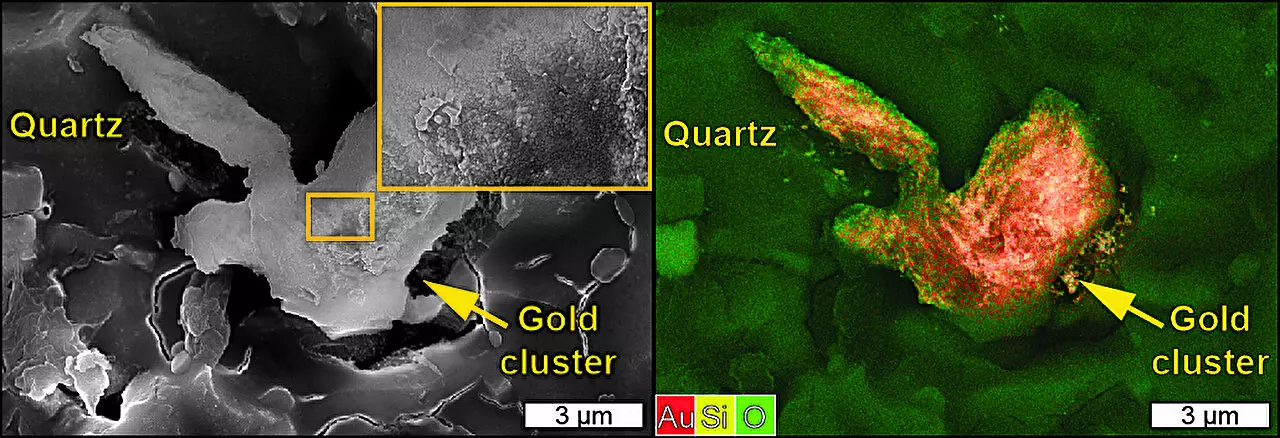The allure of gold has captivated humanity for centuries, transitioning from ancient civilizations to modern economies. What remains a persistent mystery is the formation of gold nuggets, particularly those gem-like formations nestled within quartz veins. Recent research, spearheaded by Dr. Chris Voisey at Monash University, introduces a groundbreaking perspective into this age-old enigma, suggesting that the mechanisms behind gold nugget formation may be far more dynamic and complex than conventionally understood.
Historically, the formation of gold nuggets has been attributed to the process whereby gold precipitates from hydrothermal fluids. This theory posits that as these fluids navigate through cracks in the Earth’s crust, they undergo temperature and chemical changes that lead to the deposition of gold. Although widely accepted, this explanation leaves several questions unanswered, particularly regarding the mechanisms through which significant concentrations of gold accumulate to form large nuggets. The apparent low concentration of gold in these fluids poses significant challenges to the traditional narrative, suggesting that more variables might be at play in the genesis of substantial gold deposits.
Dr. Voisey’s team directed attention towards an innovative concept—piezoelectricity. This property of quartz, the mineral typically housing gold deposits, refers to its ability to generate an electric charge when subjected to mechanical stress. Everyday applications, such as quartz watches and lighters, already showcase this phenomenon, demonstrating its remarkable implications in more familiar contexts. However, the striking suggestion that seismic activity could influence gold precipitation opens new avenues for exploration of geological processes.
To rigorously investigate this hypothesis, the research team simulated the conditions quartz might experience during seismic events. By submerging quartz crystals in a gold-rich liquid and applying mechanical stress akin to an earthquake’s shaking, they endeavored to reveal whether such stimulation could catalyze gold deposition.
The results of this controlled experiment were nothing short of extraordinary. Under the microscope, researchers observed definitive signs that the stressed quartz had not only deposited gold but also initiated the generation of gold nanoparticles. According to Professor Andy Tomkins, one of the study’s co-authors, there was a striking tendency for new gold to deposit upon established gold grains rather than forming entirely new ones.
This observation underscores an essential characteristic of the interaction between quartz and gold: while quartz acts as an electrical insulator, gold serves as a conductor, amplifying the effects of piezoelectricity. Consequently, the deposition of initial gold creates a “seed” or focal point that encourages further growth. The quartz effectively emerges as a natural battery, progressively accumulating gold in response to the repeated stress of seismic events.
Dr. Voisey’s research presents plausible explanations for the existence of large gold nuggets frequently found in earthquake-induced deposits. It suggests that the complex interplay between mechanical stress, piezoelectric properties, and chemical reactions culminates in the formation of the striking gold nuggets coveted by prospectors and collectors alike.
Moreover, this newfound perspective emphasizes the intricate relationship between the Earth’s physical forces and chemical phenomena, broadening our comprehension of geological processes. As science continues to demystify natural phenomena, the intersection of geology and physics offers promising insights into how Earth’s dynamic systems interact in extraordinary ways, yielding results that captivate both geologists and treasure hunters.
The fresh insights into gold nugget formation not only enrich our understanding of this prized commodity but also stimulate further research into the fundamental principles governing our planet’s geology. As inquiries into natural processes continue, we may uncover even more intricate tales of how Earth’s myriad forces collaborate to create the extraordinary—transforming minerals into treasures that many seek yet few truly understand. While the allure of gold remains forever potent, it is the stories and science behind its formation that captivate the imagination even more.

